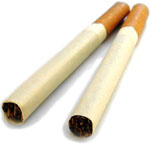The city of Providence, R.I., is taking the fight against Big Tobacco to a new level with innovative tobacco control policies. A new study, led in part by Washington University in St. Louis’ Center for Public Health Systems Science (CPHSS), details Providence’s efforts and provides a road map for other municipalities to follow.

“Tobacco companies spend an overwhelming majority of their annual marketing budget at the point of sale, an area that has not been regulated,” said Douglas A. Luke, PhD, professor at the Brown School, director of the center and principal investigator on the case study. “Providence was one of the first cities in the United States to pass ordinances to regulate price discounting and coupon redemption, and now the courts are weighing in favorably.
“This is a great public health victory,” he said.
In February 2012, Providence passed ordinances that cracked down on two tactics – sweet flavors and price discounts – used by tobacco companies to lure kids. The ordinances survived two challenges in court, most recently by the 1st U.S. Circuit Court of Appeals on Sept. 30 that affirmed a December 2012 ruling from a U.S. district court.
The CPHSS case study, “Regulating Price Discounting in Providence, R.I.” provides in-depth information about the process that Providence took to successfully develop and implement its ordinance.
“The recent court ruling has implications for other states and communities that would like to pass similar policies,” said Amy Sorg, project coordinator at CPHSS and lead author of the case study. “Our hope is that this provides them with a step-by-step, practical road map that they can use to replicate Providence’s success.
“This is a city that has taken on Big Tobacco and been successful,” she said.
Price discounts are the largest single category of advertising and promotional expenditures for both cigarette and smokeless tobacco manufacturers. In 2011, the tobacco industry spent $6.9 billion on cigarette price discounting — 83.6 percent of its advertising and promotional budget. An additional $171.2 million was spent on cigarette coupons.
“Regulating the retail environment is an emerging area in tobacco control,” Sorg said. “Many states have had success in implementing smoke-free policies and in raising tobacco taxes, but the tobacco industry is spending more and more at the point of sale. As tobacco control professionals, we really need to look at the retailer setting and figure out ways to address it.”
Kurt Ribisl, PhD, associate professor of health behavior and health education at the University of North Carolina; and Lisa Henriksen, PhD, senior research scientist at the Stanford School of Medicine’s Prevention Research Center, also are principal investigators on this study.
Funding is provided by a grant from the National Cancer Institute at the National Institutes of Health. The study also is part of the National Cancer Institute’s State and Community Tobacco Control Research Initiative. To read the full study, visit here.
To find out more about the CPHSS, visit cphss.wustl.edu.